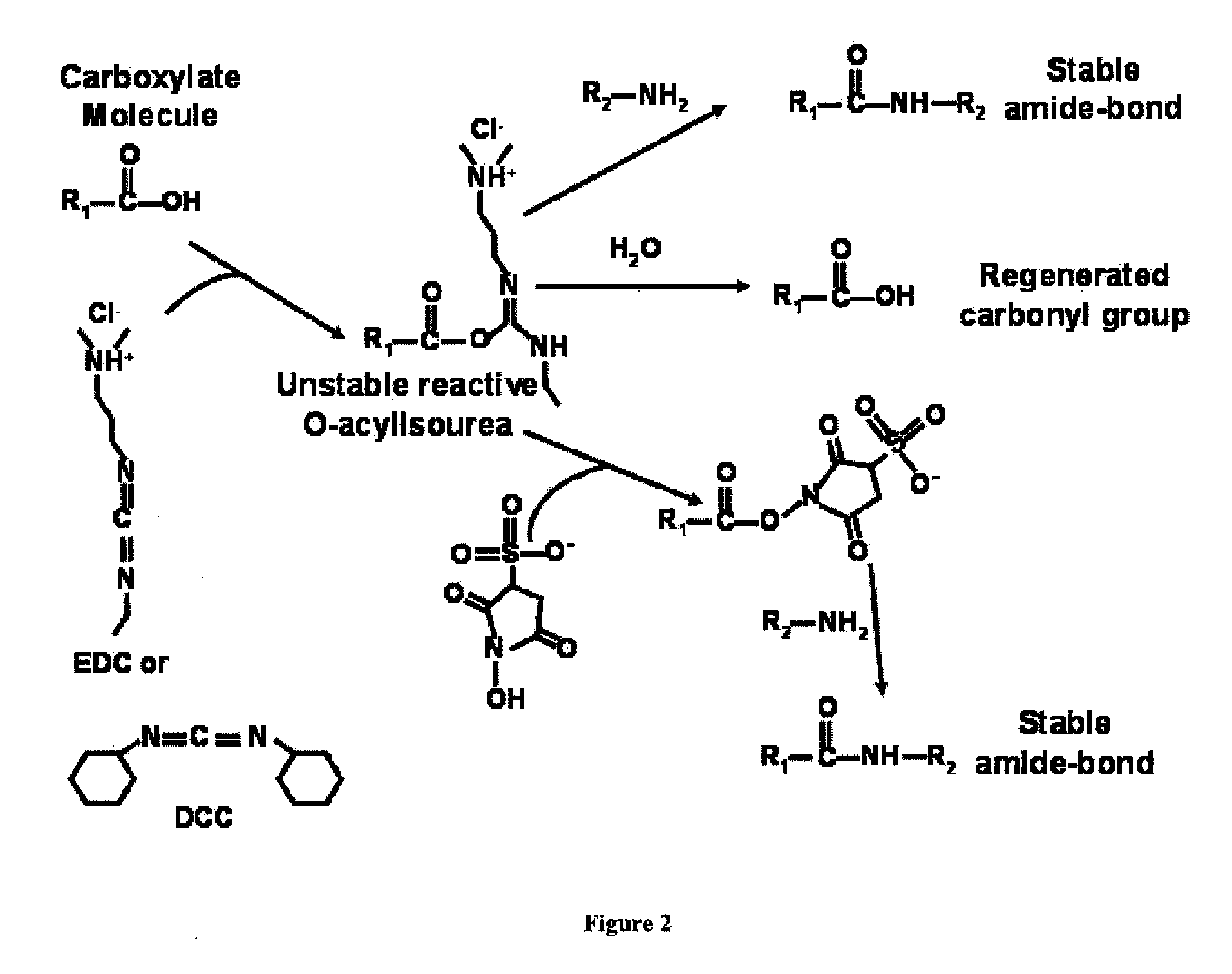Cationic-Core Carrier Compositions for Delivery of Therapeutic Agents, Methods of Making and Using the Same
a carrier composition and cationic core technology, applied in the direction of peptides, peptide sources, peptide/protein ingredients, etc., can solve the problems of unrealized therapeutic potential, short biological half-lives of low molecular masses, toxic to the organism being treated, etc., and achieve the effect of being easily adjusted
- Summary
- Abstract
- Description
- Claims
- Application Information
AI Technical Summary
Benefits of technology
Problems solved by technology
Method used
Image
Examples
example 1
[0108]Synthesis of MPEG-poly-L-lysine (5000; 40,000; 73%; 40PLPEG573): The reagents, MPEG-succinimidyl-succinate and polylysine, are commercially available and their syntheses are well known in the art. Poly-L-lysine (200 mg; Polylysine Hydrobromide; Sigma chemical Co.; DPvis:264; MWvis: 55,200; DPmalls:190; MWmalls:39,800; 0.7 mmoles aminogroup by TNBS assay Sparado et al. Anal Biochem 96:317, 1979) was dissolved in 10 ml of 0.1 M carbonate buffer pH 8.35 and 1150 mg of MPEG-succinimidyl-succinate was added, vortexed, and incubated overnight at room temperature. The next day, aliquots were taken and the amount of amino groups remaining was quantified using trinitrobenzenesulfonic acid (Sparado et al. Anal Biochem 96:317, 1979). The result indicated that 73% of amino group had been conjugated to MPEG. To cap the carboxyl terminal of polylysine that can potentially interfere with the next reaction, 600 ul of ethylenediamine and 100 mg EDC was added mixed and incubated at room tempera...
example 2
[0109]Synthesis of MPEG-poly-L-lysine (5 kDa PEG; 40 kDa PL; 55% saturation of amino groups; 40PLPEG555): The reagents, MPEG-succinimidyl-succinate and polylysine, are commercially available and their syntheses are well known in the art. Poly-L-lysine (200 mg; Polylysine Hydrobromide; Sigma chemical Co.; DPvis:264; MWvis: 55,200; DPmalls:190; MWmalls:39,800; 0.7 mmoles aminogroup by TNBS assay Sparado et al. Anal Biochem 96:317, 1979) was dissolved in 10 ml of 0.1 M carbonate buffer pH 8.35 and 900 mg of MPEG-succinimidyl-succinate was added, vortexed, and incubated overnight at room temperature. The next day, aliquots were taken and the amount of amino groups remaining was quantified using trinitrobenzenesulfonic acid (Sparado et al. Anal Biochem 96:317, 1979). The result indicated that 55% of the amino groups had been conjugated to MPEG. To cap the carboxyl terminal of polylysine that can potentially interfere with the next reaction, 600 ul of ethylenediamine and 100 mg EDC was ad...
example 3
[0110]Synthesis of MPEG-poly-1-lysine (5 kDa PEG; 40 kDa PL; 22% saturation of amino groups; 40PLPEG522): The reagents, MPEG-succinimidyl-succinate and polylysine, are commercially available and their syntheses are well known in the art. Poly-L-lysine (200 mg; Polylysine Hydrobromide; Sigma chemical Co.; DPvis:264; MWvis: 55,200; DPmalls:190; MWmalls:39,800; 0.7 mmoles aminogroup by TNBS assay Sparado et al. Anal Biochem 96:317, 1979) was dissolved in 10 ml of 0.1 M carbonate buffer pH 8.35 and 600 mg of MPEG-succinimidyl-succinate was added, vortexed, and incubated overnight at room temperature. The next day, aliquots were taken and the amount of amino groups remaining was quantified using trinitrobenzenesulfonic acid (Sparado et al. Anal Biochem 96:317, 1979). The result indicated that 22% of amino groups had been conjugated to MPEG. The solution (200 ml) was washed by filtration through 100 kDa cut-off filter membrane (Amersham Biosciences Corp, Westborough, Mass.) with five chan...
PUM
| Property | Measurement | Unit |
|---|---|---|
| Fraction | aaaaa | aaaaa |
| Fraction | aaaaa | aaaaa |
| Fraction | aaaaa | aaaaa |
Abstract
Description
Claims
Application Information
 Login to View More
Login to View More - R&D
- Intellectual Property
- Life Sciences
- Materials
- Tech Scout
- Unparalleled Data Quality
- Higher Quality Content
- 60% Fewer Hallucinations
Browse by: Latest US Patents, China's latest patents, Technical Efficacy Thesaurus, Application Domain, Technology Topic, Popular Technical Reports.
© 2025 PatSnap. All rights reserved.Legal|Privacy policy|Modern Slavery Act Transparency Statement|Sitemap|About US| Contact US: help@patsnap.com



